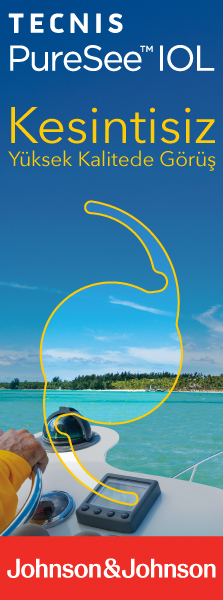Bu derlemede kronik oküler hipotoninin tanı, etyopatogenezi ve cerrahi başta olmak üzere tedavi seçenekleri tartışılmıştır. Hipotoninin temel nedeni; artmış aköz hümör dışa akımı ve azalmış aköz hümör üretimidir. Aşırı fi ltrasyon çoğu vakada cerrahi olarak iyi tedavi edilebilebirken, siliyer disfonksiyonunun etkin ve kalıcı bir tadavisi yoktur. Siklitik membranların temizliği ve traksiyonların rahatlatılması göz içi basıncında orta düzeyde bir artış sağlamaktadır. Bir miktar aköz salınımının olduğu durumlarda dışa akım yolunun kapsül germe halkası ile blokajı hipotoniyi tedavi etmede etkin bulunmuştur. Fakat, aköz hümör salınımının olmadığı gözlerde bu blokaj başarısız olacaktır. Siliyer doku transplantasyonu veya ventrikülo-vitreal (serebrovitreal) şant uygulamaları bu gözlerde fitizis bulbi gelişimini önlemede umut vadeden tedavi yöntemleri olabilir.
INTRODUCTION
Chronic ocular hypotony(COH) is the main cause of eye
loss in situations where anatomical integrity is preserved
after trauma or intraocular surgery. COHis a devastating
process for both ophthalmologists and patients, resulting
in blurred visioni painful eye and phthisis bulbi.Ocular Hypotony
is defi ned as the intraocular pressure(IOP) below 6
mmHg, but severe visual loss occurs below 4 mmHg.[1-4 Hypotony
develops when aqueous humor production falls to
10% of normal.[5 The prolongation of the hypotony resultsin a decreased production of aqueous humor by impairing the
blood aqueous barrier, which causes a vicious cycle of hypotony.
3 Clinically, structural and functional defects such as
cataract, corneal edema, maculopathy, papillary edema and
visual loss develop and hypotony can result in phytisis bulbi
in untreated eyes.[4]
Suppression of infl ammation by corticosteroids is the basis of medical treatment.Intravitreal viscoelastic agents, perfl uorocarbon, gas and silicone oil injections are also well known surgical treatment options.[2-5] In selected cases, removing epiciliary and anterior proliferative vitreoretinopathy (PVR) membranes may be effective. The level of atrophy of the ciliary epithelium directly affects the outcome of all treatment options.The development of new methods to ensure full recovery is required.In this review, etiopathogenesis and surgical treatment of COH approaches will be discussed.
CAUSES OF HYPOTONY
Increased Filtration
Traumatic lacerations and surgical wound leakage cause hypotony
externally. Cyclodialysis, ciliocoroidal detachment,
retinal detachment, and extensive retinectomies cause hypotony
internally with internal leakage from the suprachoroidal
space.[2,4]
Decreased Production
The hypotony that develops as a consequence of ciliary body
failure is the most diffi cult type to cope with. Inflammation
is a primary component of the pathogenesis of COH. Inflammation
reduces aqueous production via prostaglandins and
at the same time causes an increase in uveoscleral outfl ow.[6]
Anterior PVR and cyclitic membranes cause chronic traction,
which damages the choroidal blood flow of the ciliary
body and reduces aqueous production.5 Having more than 2
clock-face of ciliary dialysis is sufficient for hypotony.[7] Ciliochoroidal
detachment creates a hypotonic cycle by increasing
uveoscleral outfl ow and reducing aqueous production.
Hypotony may develop following vitreoretinal surgery;excessive laser and cryo applications under the repressive effect of silicone oil,[8] ciliary atrophy, proliferative membranes, deep scleral indentation, extensive retinotomy and retinectomy, [9-11] lensectomy, toxic effect of silicone oil, ciliochoroidal and retinal detachment.[4]
Medical Treatment
Corticosteroids constitute the basis of medical treatment because
of its effect on infl ammation control.The increase in
IOP is thought to be due to suppression of infl ammation and
increased outfl ow resistance.[12,13] It has been shown that oral,
periocular, topical and intravitreal steroids are effective in
the treatment of COH.[14,15] It is believed that the short-term
control provided by steroid therapy has broken the vicious
circle of hypotony. A current treatment alternative is topical
2% ibopamine administration, a nonselective dopaminergic
agent. It has been reported that this treatment provides sustained
IOP elevation in cases of resistant hypotonia that has
undergone vitreoretinal surgery several times due to retinal
detachment, but it is inadequate in functional success and
diffi cult to use due to local side effects of the drug.[16,17]
Surgical Treatment
Surgical method should focus on the underlying cause of
COH.If the underlying cause is treated properly, signifi cant
structural and functional improvement has been observed,
even in eyes with hypotony for a long time.[18]
Intraocular injections
Clinical studies show that sodium hyaluronate provides adequate
vitreous support.[19] Injection of viscoelastic material
into the anterior chamber or vitreous cavity provides effective
but transient treatment for COH.[20-22] It is thought to be
more effective on postoperative early hypotony and to break
the vicious cycle of hypotony by eliminating the possible
shallow detachment in the ciliary body.[20,23] Ifciliary insuffi -
ciency is present, the chances of success are low.Complications
such as prolonged inflammation and endophthalmitis
due to repeated injections limit their use.The use of viscoelastic
material at high concentration reduces the injection
frequency.[20,21,24]
Repeated fluid-gasexchange in the hypotony after PVR surgery also prevents phytisis bulbi temporarily, but silicone oil may be needed for a longer duration of fi lling effect in some cases.[26] Silicone oil injection is a mandatory therapeutic option in the treatment of COH[2 ,4,27-29] when the ciliary epithelium and it?s extensions are ischemic and atrophic. Although permanent vitreous support provided by silicone oil may be suffi cient to maintain IOP, the feeding of school tissues due to aqueous humor defi ciency and oxygenation is impaired. In this situation, damage to the ocular tissues may progress and phytisis bulbi may develop.
In cases with the ciliary body disfunction that is due to epiciliary membranes; If these epiciliary , cyclitic membranes are cleaned and ciliochoroidal detachment is absent, ocular tonus can usually be restored with long-term silicone oil tamponade. Additional silicone oil injections may be required due to increased ocular volume induced by silicone oil to maintain IOP and achieve better visual functions.[30]
Removing anterior PVR membranes and epiciliary, cyclitic
membranes
Ciliochoroidal detachment and ciliary body dysfunction are
the leading causes of hypotony after vitreoretinal surgery.
Anterior PVR, also referred to as proliferative vitreociliopathy,
causes tractional ciliochoroidal detachment. This
reduces aqueous production by disrupting the choroidal
blood fl ow of ciliary body.[7] Cyclitic membranes cause hypotonia
by a similar mechanism.Vitreoretinal surgery with
transpupillary approach, in which cyclitic membranes have
been removed and ciliary body traction have been relieved,
provides an effective and sustainable IOP increase in selected
cases.[27,31] Ciliary body can be assessed preoperatively by ultrasonic biomicroscopy or by direct visualization during
surgery.Regardless of etiology, removal of membranes and
relieving ciliary tractions were found to be sufficient for hypotony
control in cases where ciliary extensions were normal.
[27,31,32] However, it is emphasized that this surgery is a
rescue treatment and the functional success is achieved in
a limited number of patients.[11,31] In the presence of severe
ciliary atrophy, this surgical approach is ineffective.In this
case, permanent silicone oil tamponade is inevitable to obtain
enough IOP to prevent the development of phytisis bulbi.
[27] Endoscopic vitrectomy is thought to be superior to the
conventional method because it reveals tractions that can be
overlooked due to scleral indentation.Especially young age
and low numbers of previous vitreoretinal surgeries have
been associated with positive outcome.
Reparation of ciliary body dialysis
Cyclodialysis, which can be seen as a complication of blunt
trauma or intraocular surgery, is defined as the separation
of the ciliary muscle from the scleral spur.Due to the direct
aqueous passage between the anterior chamber and the suprachoroidal
space, uveoscleral outflow is increased.Gonioscopy
in anteriorly placed dialysis and ultrasound biomicroscopy
in posterior dialysis are more useful to identify the
dialysis.Anterior chamber narrowing is rare despite excessive
fi ltration, if anterior chamber is shallow, the diagnosis
can be made with gonioscopy after the anterior chamber is
formed with viscoelastic material. The cyclodialysis cleft
may occasionally close up as it rarely causes a sudden increase in IOP.Cycloplegia made with topical atropine can
help the ciliary body to shift to the sclera by reducing the
tonus of the ciliary muscle.[33] Arguments such as argon laser
photocoagulation, diode and YAG laser cyclophotocoagulation
have been found effective in the case of medical treatment
failures.[33-35]
Methods used in the surgical treatment of closure-resistant cyclodialysis cleft are; direct cyclopexy, cryotherapy, anterior scleral buckling, pars plana vitrectomy with gas endotamponade or with endoscopic suturation, capsular tension ring suturation at sulcus and 3 piece intraocular lens application.[36-40]
Placement of capsular tension ring to the iridocorneal angle
The primary pathway responsible for the aqueous humoral
outfl ow is the trabecular meshwork. Blocking the iridocorneal
angle will increase IOP by reducing aqueous outfl ow
from the trabecular meshwork.Argon laser-induced sclerosis
in the trabecular meshwork has treated chronic hypotony
by increasing aqueous outfl ow resistance.[41]
Gürelik et al. placed a capsular tension ring (CTR) to the iridocorneal angle to blockthe aqueous ourfl owfl ow in COH patients andachieved a sustained increase in IOP and a signifi cant improvement in visual function (Gürelik G, Dişli G: A New Surgical Technique to treat hypotony. AAO absract, 2014).The surgical technique is simple.A CTR (11-13 mm or 12-14 mm) is placed to the iridocorneal angleviaa small corneal incision (Figs. 1a, 1b, 1e, 1d). It is emphasized that the success rate of this technique depends on the amount of remaining intact secreting ciliary epithelium.
New and Promising Surgical Therapeutic Options in The
Future
Ciliary Body Transplantation
As described in detail above, complete loss of function of
ciliary epitheliumappears after traumatic, surgical or inflammation-
induced ciliary tissue damage. This dysfunction is
irreversibe and thedevelopment of the phytisis bulbi due to
ocular hypotonia is inevitable if not treated efficiently. Another
option in this regard is to provide a functional healthy
tissue. Since it was difficult and traumatic to reach the posterior
of the iris, ciliary tissue allografts are placed in the anterior
surface of the iris or iridocorneal angle in experimental
models (Fig. 2a, 2b).The anterior chamber is immunologically
protected and nutritional support makes it a suitable
stage for tissue transplantation.It has been shown that the
ciliary tissue graft placed in the intact anterior chamber of
the immunosuppressed host is well perfused andbe able to
produce aqueous humor and it?s epithelial cell morphology
is protected (Figs. 3a, 3b).[42-44] Although the results of ciliary
tissue transplantation can not be predicted in the eyes with
hypotonia , it seems to be a promising method to treat COH. However, the need for immunosuppression is a serious limiting
factor and there is no clinical studies yet.
Cerebro-Vitreal shunt
There are no medical and surgical treatments to stimulate
aqueous release from the damaged ciliary body in studies
carried out so far.
As a second treatment option for these none aqueous secreting eyes a new surgical model was planned. In order to fill the eye with an aqueous humor-like fluid, cerebrospinal fluid was transferred into the vitreous cavity via shunt tube in an experimental study.
For this purpose, Gurelik et al. have defi ned a new experimental hypotony model that is effective and can be created in a short time. Severe hypotony was provided in rabbit eyes undergoing 360 degree argon laser endoscopic cyclocoagulation after lensectomy and vitrectomy (Figures 4a, 4b, 4c). After that procedure, some hypotonic eyes were treated by fi lling the eyes with balanced salt solution from the outside using the vitreal shunt system (Figures 5a-d).This study has shown that vitreal shunting is feasible (Gurelik G et al, unpublished information). An additional experimental study showed cerebro-vitreal shunting prevented eyes from phythisis bulbi in experimentally induced severe hypotony eyes. (Gurelik G et al, unpublished information)
Figure 5a-d: Vitreal shunt placement into the eye.
The aqueous humor and cerebrospinal fluid have very close physical and chemical properties. In addition, IOP is similar to normal brain spinal fluid pressure (4-13 mmHg). This preliminary studieshave created a prototype for the subsequent cerebro-vitreal shunt procedure to treat COH.
REFERENCES / KAYNAKLAR





